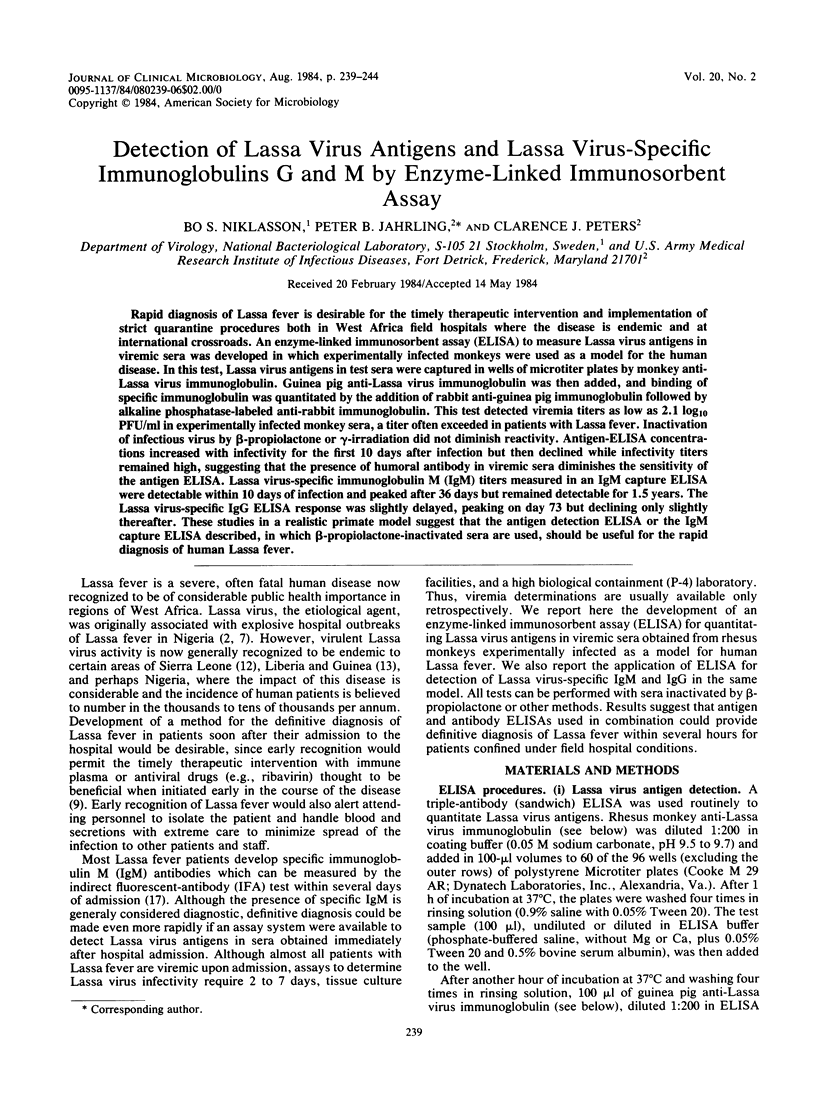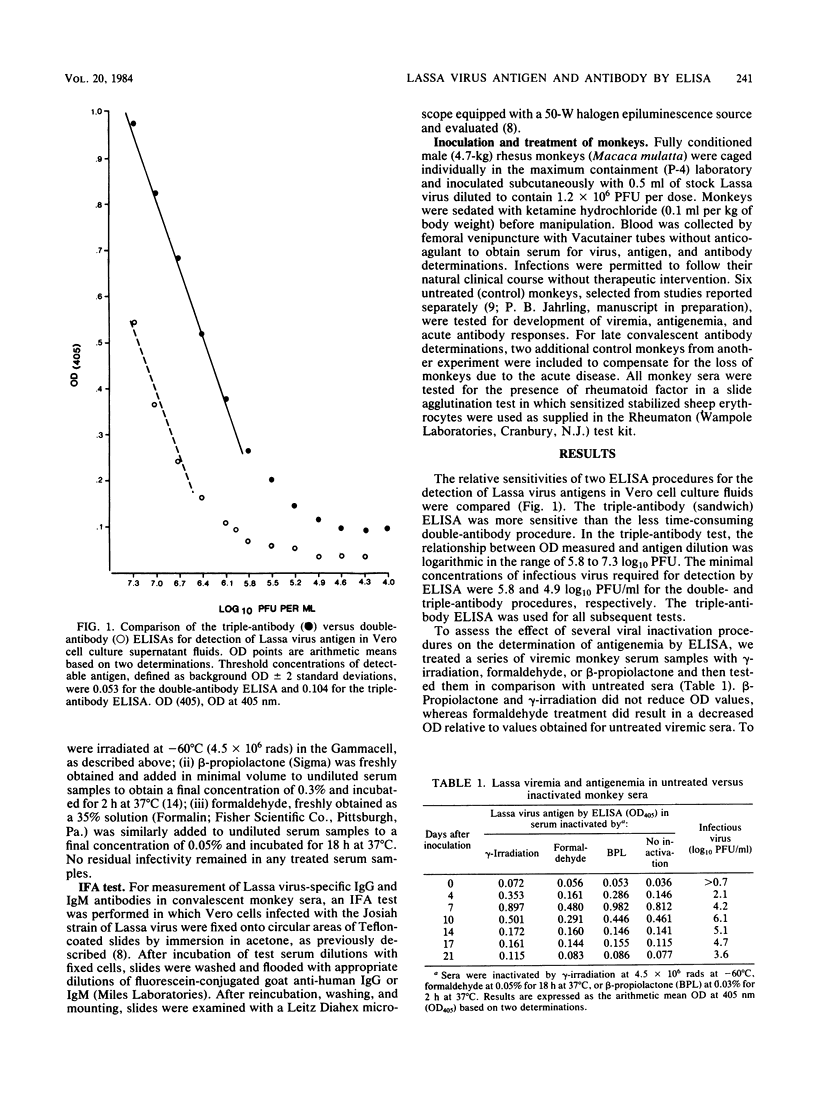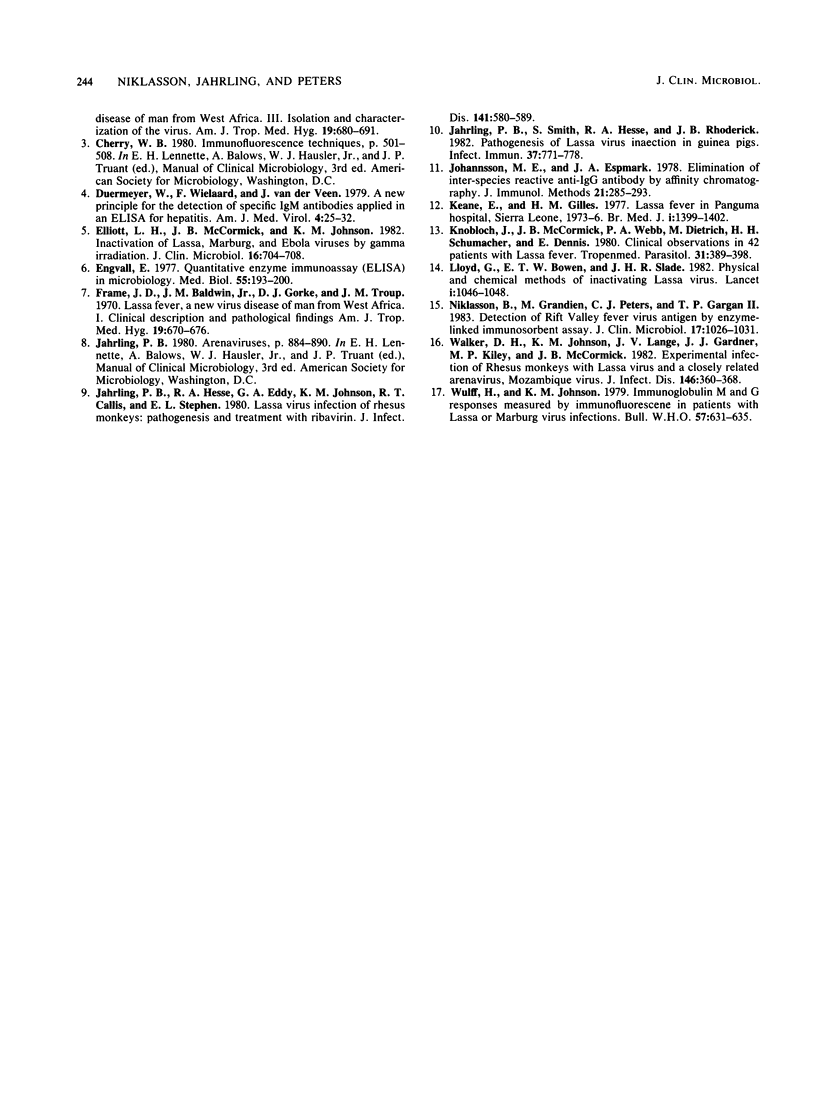Abstract
Rapid diagnosis of Lassa fever is desirable for the timely therapeutic intervention and implementation of strict quarantine procedures both in West Africa field hospitals where the disease is endemic and at international crossroads. An enzyme-linked immunosorbent assay (ELISA) to measure Lassa virus antigens in viremic sera was developed in which experimentally infected monkeys were used as a model for the human disease. In this test, Lassa virus antigens in test sera were captured in wells of microtiter plates by monkey anti-Lassa virus immunoglobulin. Guinea pig anti-Lassa virus immunoglobulin was then added, and binding of specific immunoglobulin was quantitated by the addition of rabbit anti-guinea pig immunoglobulin followed by alkaline phosphatase-labeled anti-rabbit immunoglobulin. This test detected viremia titers as low as 2.1 log10 PFU/ml in experimentally infected monkey sera, a titer often exceeded in patients with Lassa fever. Inactivation of infectious virus by beta-propiolactone or gamma-irradiation did not diminish reactivity. Antigen-ELISA concentrations increased with infectivity for the first 10 days after infection but then declined while infectivity titers remained high, suggesting that the presence of humoral antibody in viremic sera diminishes the sensitivity of the antigen ELISA. Lassa virus-specific immunoglobulin M (IgM) titers measured in an IgM capture ELISA were detectable within 10 days of infection and peaked after 36 days but remained detectable for 1.5 years. The Lassa virus-specific IgG ELISA response was slightly delayed, peaking on day 73 but declining only slightly thereafter. These studies in a realistic primate model suggest that the antigen detection ELISA or the IgM capture ELISA described, in which beta-propiolactone-inactivated sera are used, should be useful for the rapid diagnosis of human Lassa fever.
Full text
PDF





Selected References
These references are in PubMed. This may not be the complete list of references from this article.
- Duermeyer W., Wielaard F., van der Veen J. A new principle for the detection of specific IgM antibodies applied in an ELISA for hepatitis A. J Med Virol. 1979;4(1):25–32. doi: 10.1002/jmv.1890040104. [DOI] [PubMed] [Google Scholar]
- Elliott L. H., McCormick J. B., Johnson K. M. Inactivation of Lassa, Marburg, and Ebola viruses by gamma irradiation. J Clin Microbiol. 1982 Oct;16(4):704–708. doi: 10.1128/jcm.16.4.704-708.1982. [DOI] [PMC free article] [PubMed] [Google Scholar]
- Engvall E. Quantitative enzyme immunoassay (ELISA) in microbiology. Med Biol. 1977 Aug;55(4):193–200. [PubMed] [Google Scholar]
- Frame J. D., Baldwin J. M., Jr, Gocke D. J., Troup J. M. Lassa fever, a new virus disease of man from West Africa. I. Clinical description and pathological findings. Am J Trop Med Hyg. 1970 Jul;19(4):670–676. doi: 10.4269/ajtmh.1970.19.670. [DOI] [PubMed] [Google Scholar]
- Jahrling P. B., Hesse R. A., Eddy G. A., Johnson K. M., Callis R. T., Stephen E. L. Lassa virus infection of rhesus monkeys: pathogenesis and treatment with ribavirin. J Infect Dis. 1980 May;141(5):580–589. doi: 10.1093/infdis/141.5.580. [DOI] [PubMed] [Google Scholar]
- Jahrling P. B., Smith S., Hesse R. A., Rhoderick J. B. Pathogenesis of Lassa virus infection in guinea pigs. Infect Immun. 1982 Aug;37(2):771–778. doi: 10.1128/iai.37.2.771-778.1982. [DOI] [PMC free article] [PubMed] [Google Scholar]
- Johansson M. E., Espmark J. A. Elimination of inter-species reactive anti-IgG antibodies by affinity chromatography. J Immunol Methods. 1978;21(3-4):285–293. doi: 10.1016/0022-1759(78)90155-2. [DOI] [PubMed] [Google Scholar]
- Keane E., Gilles H. M. Lassa fever in Panguma Hospital, Sierra Leone, 1973-6. Br Med J. 1977 May 28;1(6073):1399–1402. doi: 10.1136/bmj.1.6073.1399. [DOI] [PMC free article] [PubMed] [Google Scholar]
- Knobloch J., McCormick J. B., Webb P. A., Dietrich M., Schumacher H. H., Dennis E. Clinical observations in 42 patients with Lassa fever. Tropenmed Parasitol. 1980 Dec;31(4):389–398. [PubMed] [Google Scholar]
- Lloyd G., Bowen E. T., Slade J. H. Physical and chemical methods of inactivating Lassa virus. Lancet. 1982 May 8;1(8280):1046–1048. doi: 10.1016/s0140-6736(82)92101-8. [DOI] [PubMed] [Google Scholar]
- Niklasson B., Grandien M., Peters C. J., Gargan T. P., 2nd Detection of Rift Valley fever virus antigen by enzyme-linked immunosorbent assay. J Clin Microbiol. 1983 Jun;17(6):1026–1031. doi: 10.1128/jcm.17.6.1026-1031.1983. [DOI] [PMC free article] [PubMed] [Google Scholar]
- Walker D. H., Johnson K. M., Lange J. V., Gardner J. J., Kiley M. P., McCormick J. B. Experimental infection of rhesus monkeys with Lassa virus and a closely related arenavirus, Mozambique virus. J Infect Dis. 1982 Sep;146(3):360–368. doi: 10.1093/infdis/146.3.360. [DOI] [PubMed] [Google Scholar]
- Wulff H., Johnson K. M. Immunoglobulin M and G responses measured by immunofluorescence in patients with Lassa or Marburg virus infections. Bull World Health Organ. 1979;57(4):631–635. [PMC free article] [PubMed] [Google Scholar]


